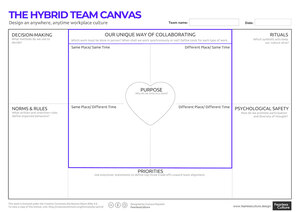Hybrid Team Canvas

The Hybrid Team Canvas is a framework and tool to design a hybrid or remote-first team culture.
Goal
Map and design your hybrid team culture
Adapt your team culture and practices to a hybrid environment
Balance asynchronous and synchronous team collaboration
Materials
Instructions
Here's a summary of key facilitation steps:
1. Team Purpose
If your team already has a purpose, just add it to the canvas and move to the next step.
The team purpose is the reason the team exists within your organization. It defines the impact all members want to create together. The team purpose captures how a group will help the organization achieve their purpose.
The team purpose translates the organization’s purpose into something to which people can relate. Not only does it define ‘why’ the team exists, but also drives people into action. Studies show that belonging to a team (subculture) can double employee engagement.
To develop your team purpose address the following questions:
#1 – What does your team do?
#2 – Who do you work for?
#3 – What impact do we want to create?
Example:
“Our team provides efficient support so that our managers can spend more time leading.”
Learn how to facilitate the Team Purpose exercise and download the template.
2. Define Your Team Priorities
Establishing priorities is a trade-off between two good things. Use even/ over statements to define which one people must choose when there’s a conflict.
Here are some examples of priorities to address common tensions affecting hybrid teams.
“Outcome even over effort.”
“Flexible schedules even over synchronous work.”
“Team members wellbeing even over productivity.”
Consider the above examples as a starting point. Your team reality might require you consider other variables. Choose 3 priorities.
3. Our Unique Way of Collaborating
Finding the right collaboration approach not only entails considering what’s best for a particular activity (decision-making, brainstorming, on-boarding new employees, etc.), but also its cost.
Have participants tackle each quadrant, one at a time, finding commonalities and differences. Focus on the latter and have team members discuss the pros and cons.
Some thoughts to help kickstart the conversation:
- Design sprints and the solving of complex problems work better when everyone’s working at the same time
- Providing feedback on the ideas can be done asynchronously
- Reviewing materials and preparing for a meeting or simple training are things everyone can do at their own pace
- Defining a new strategy, attending immersive training, or discussing reorganization require a different attention; thus, it’s more critical to have
Capture all the agreements on the Hybrid Team Canvas.
To promote better conversations, I recommend reading The Six Modes of Work for Distributed Teams – when it makes sense to collaborate or work at our own pace.
4. Promote Psychological Safety in a Hybrid Team
Hybrid work is adding an extra layer to psychological safety. The line between work and personal is even more blurred. A flexible approach can seed distrust about people choices: will my colleagues choose what’s right for the team or what’s more convenient for them? Are the “locals” willing to abide by a remote-first practice?
For example, at Trello, if only one person joins a meeting remotely, the rest of the team adapts. Everyone takes the video call from their desks to empathize with the remote members and ensure everyone is treated fairly.
Similarly, rotating time zones ensures that those that work from home most of their time don’t always have to adapt to the ‘headquarters’ time.”
5. Team Rituals for a Hybrid Workplace
What are the team rituals to celebrate when everyone’s together?
Which rituals can people who are in the same room practice to celebrate those who are working remotely?
Which remote team rituals will continue to be practiced in this new hybrid scenario?
For example, online whiteboard company Miro onboards remote employees in cohorts. This approach allows people to learn about the company culture and strategy and, at the same time, familiarize themselves with their colleagues.
Learn more about how to design team rituals or check these remote rituals for inspiration.
6. Rules and Norms for Hybrid Teams
A hybrid workplace culture requires more flexibility than ever. The challenge lies in setting rules that balance freedom and accountability.
Define specific “collaboration days” and “no-meeting days/ hours” so people can design their schedule around those.
There’s no one-size-fits-all approach when it comes to a hybrid workplace. The nature of each role will require different rules. Similar to Indeed’s approach, Citigroup categorized all jobs into three groups: “resident,” “remote,” or “hybrid.” The requirement of the work, not people’s preferences, defines who’s eligible for each bracket.
Keep your rules simple and flexible, but don’t forget to clarify expected behaviors and how performance will be measured.
7. Decision-Making
Align on how your team decides in a hybrid model.
On top of selecting the right decision-making methods, a hybrid team culture requires considering how flexible schedules can affect how the team decides.
Which decisions will be made asynchronously and which require that everyone is present? How will you overcome biases when not everyone’s in the same room?
Which decisions should happen only when everyone’s in the same room? Which may require special coaching or to be discussed in 1-on-1s before addressing them with the entire team?
Attachments
- the hybrid team canvas design culture by Gustavo Razzetti small.jpg
Background
The Hybrid Team Canvas was created by Gustavo Razzetti, CEO of Fearless Culture in early 2021. It's an offspring of his Culture Design Canvas – the tool for mapping, assessing, and designing company and team culture.